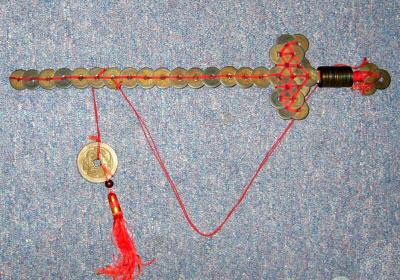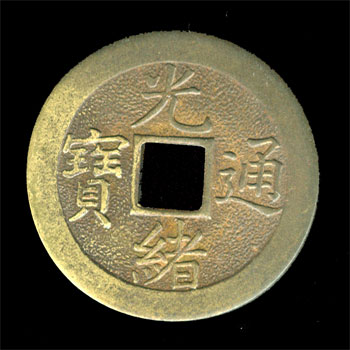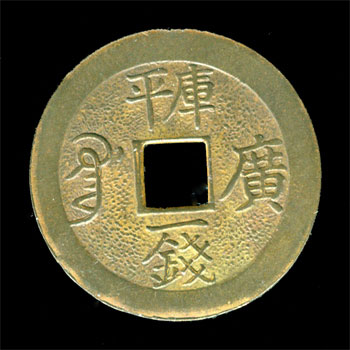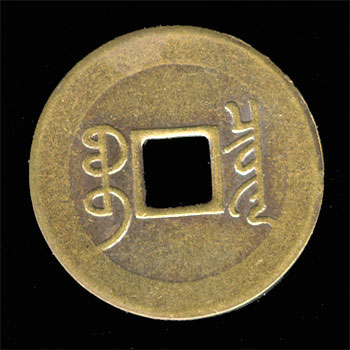A recent adventure in attempting the de-accession of a Chinese "collectable" a Chinese Money Sword, lead to the confirmation, that the Chinese have been forging "fake" cash coins from as far back as over a hundred years ago or longer.
The story starts with a purchase of one of these Chinese Money Swords from a numismatist friend, about thirty years ago. The tale, which went with the item, described how he had acquired the sword from his Father, then at the time, a English soldier serving in the British Colony of Hong Kong around 1900 AD.
The Chinese Money Sword was put up on eBay for sale. There were a number of "looks", but no bids. My sword did not sell.

Twenty odd years ago I acquired this Chinese Cash Sword from a member friend - Robert (Bob) A. Spence of Boynton Beach. At the time he told me the story of how it had been handed down from his father, Andrew W. Spence. Andrew had served in his Queens British Army in Hong Kong about the time of the turn of the century, where he had purchased this souvenir of China. Bob was told by his father that the Chinaman who had several of these coin swords, passed on the story that it had been used by a Chinese Guard for "protection". I think the "protection" was to keep away "ghosts and evil spirits".
Chinese Cash coins strung on metal rod
Chinese cash swords In the 19th century, were tied with string on both sides of an iron rod about 2 feet long. At one end the coins fanned out into roughly a triangular shape, and beyond this, to the end of the rod, coins were stacked with the iron rod going through the center hole of the coins. These stacked coins formed the handle of the sword.
The coin sword was an amulet given to newly married couples, to hang above their bed, to ward off evil spirits.
During the last 20 years, imitations of cash swords have appeared on the collector market. The old cash swords have a square hand made iron bar inside. The strings are usually red. The modern imitations usually have a round, smooth, machine made bar inside.
One book, which mentions and illustrates a cash sword, is Social Life of the Chinese by Justus Doolittle, published in 1868. Doolittle was an American missionary at Foochow in Fukien province from 1850 to 1873. The use of a cash sword may have been a local custom in the Fukien area. Cash swords are probably more common than we think.
The next step was to take the sword apart for the Chinese cash coins, as on first identification there seemed to be a few better types, plus the usual common cash. This effort required little time, but it was noted that the coins were very well tied together, taught, with the usual red string on a flat iron rod. They certainly looked, as originally described by the first owner. Many had original mint luster, and some were beautifully toned with several colors of the rainbow. We counted 12 of the variety and 86 coins of the more common cash. The rod was most interesting. It was made of iron with 19 holes in it, with a silver like paint, except where the paint had worn off and rust was present.

The discovery: Scans of the two types of cash coins were made.


Machine made reproduction - Y189


The common cash - Board of Revenue
Thanks go to Scott Semans, (Asian specialist and numismatic dealer) who identified -
"The cash in the illustrations are not genuine pieces. I think both the common cash and the "Y189" are the sort made today to put into "10 Emperor" sets that are sold on cards. Up until about 10-15 years ago the genuine cash were cheap enough that genuine pieces were used in card sets and swords, so it does tend to show that either this is a fairly modern sword, or somebody was making these up longer ago than I'd thought."
Chinese Cash had very little Value, but High Purchasing Power
Chinese Coinage – Money differs in each province of China. The standard of silver is the tael, a Chinese ounce, varying from one to two or more ounces avoirdupois. In some provinces silver is used for large and small coins, with the exception of the smallest denomination, the copper. Formerly most of the Szechuen, and therefore Chungking, coins were small circular copper pieces with holes in the middle, called cash. These were worth about one-tenth of a copper, which in turn was equal to one-half, or more, of a United States copper cent. In the past few years Szechuen has collected most of these small cash and melted them. In their new form they circulate as coppers of varying size, called fifty cash, one-hundred cash, two-hundred cash, five-hundred cash pieces. A fifty-cash piece is equal to about two cents in United States coinage, but its purchasing power is very much greater that that of two cents. One dollar of United States currency [or a thousand cash] would feed two people of the lower class for a month. This, however, would be food of the simplest kind – tea, rice, and an occasional vegetable or fruit, and meat or fish once a week.Elizabeth Foreman Lewis, Young Fu of the Upper Yangtze, (1934) pp.262.
The conclusion: Since I have had the Chinese Money Sword for close to thirty years and the Spence family before this; seventy-five odd years, it confirms that the Chinese have been forging ‘fake’ cash for at least a hundred years, as the value of the ‘fakes’ was less than the authentic cash. It is interesting that according the Scott Semans, they are still using the same ‘dies’ for these fake cash today.
Roger deWardt Lane, Hollywood, Florida